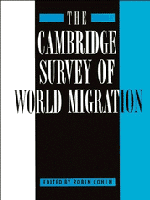Book contents
- Frontmatter
- Contents
- List of illustrations
- List of tables
- Notes on the contributors
- 1 Prologue
- 2 European colonization and settlement
- 3 Asian indentured and colonial migration
- 4 The great Atlantic migration to North America
- 5 Migration in Europe, 1800–1950
- 6 Migration in Africa
- 7 Latin and Central American migration
- 8 Migration to North America after 1945
- 9 Labour migration to western Europe after 1945
- 10 Repatriates and colonial auxiliaries
- 11 Migration in Asia and Oceania
- 12 Migration in the Middle East
- 13 Refugees from political conflict
- 14 Migrants and asylum-seekers in contemporary Europe
- 15 Emerging trends
- Acknowledgements and credits
- Index
7 - Latin and Central American migration
Published online by Cambridge University Press: 05 December 2012
- Frontmatter
- Contents
- List of illustrations
- List of tables
- Notes on the contributors
- 1 Prologue
- 2 European colonization and settlement
- 3 Asian indentured and colonial migration
- 4 The great Atlantic migration to North America
- 5 Migration in Europe, 1800–1950
- 6 Migration in Africa
- 7 Latin and Central American migration
- 8 Migration to North America after 1945
- 9 Labour migration to western Europe after 1945
- 10 Repatriates and colonial auxiliaries
- 11 Migration in Asia and Oceania
- 12 Migration in the Middle East
- 13 Refugees from political conflict
- 14 Migrants and asylum-seekers in contemporary Europe
- 15 Emerging trends
- Acknowledgements and credits
- Index
Summary
In one of the first novels in English, published in 1719, Daniel Defoe famously tells of the adventures of a footloose seaman, Robinson Crusoe. After suffering various misfortunes, including being himself enslaved for two years, Crusoe finds a modicum of success in ‘the Brasils’, where he begins ‘to thrive and prosper very well upon [his] plantation’. He reminisces to his fellow planters about his two voyages to the Guineas and, in particular, about ‘how easy it was to purchase upon the coast, for trifles, such as beads, toys, knives, scissors, hatchets, bits of glass and the like, not only gold dust, Guinea grains, elephants teeth, etc., but negroes, for the service of the Brasils, in great numbers’. Their eyes light up at the mention of the last commodity, for slaves were expensive and a monopsony was exercised by the kings of Spain and Portugal. His planter friends offer to fit out a ship if Crusoe will act as a supercargo to pick up slaves and return them, illegally, to Brazil. His greed gets the better of him and he accepts their offer, only to suffer the crowning mischance of a shipwreck and exile on a desert island.
Naturally this story can be dismissed as mere fiction, but economists have used the tale to anchor some of their most fundamental theories (Marx, for example, deployed it to illustrate his labour theory of value), while literary critics have concurred with Defoe's own remark that ‘the Story, although allegorical, is also historical’.
- Type
- Chapter
- Information
- The Cambridge Survey of World Migration , pp. 203 - 232Publisher: Cambridge University PressPrint publication year: 1995



